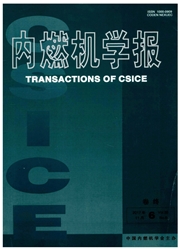

 中文摘要:
中文摘要:
在一台高压共轨柴油机上对汽油均质混合气柴油引燃(HCII)低温燃烧的燃烧特性、排放特性和热效率进行了研究.结果表明:随着进气道预混汽油比例增加,NO和碳烟排放同时显著降低,当汽油比例超过0.7并且用废气再循环方法实现低温燃烧时,NO排放低于15×10-6,碳烟排放几乎为0;随汽油比例增加,滞燃期增长,燃烧持续期缩短,最大压力升高率明显降低,指示热效率明显高于点燃式燃烧方式,达到甚至好于柴油压燃燃烧方式.随着着火相位推后,纯柴油的碳烟排放升高而NO排放降低,呈现trade-Off关系.而汽油/柴油HCII模式的NO和Soot始终未出现trade—off关系.
 英文摘要:
英文摘要:
Low temperature combustion of gasoline homogeneous charge induced ignition (HCII) by diesel was studied in a high-pressure common-rail diesel engine. Combustion characteristics, emissions and thermal efficiency of gasoline/diesel HCII are investigated in details. Results show that high gasoline ratio offers simultaneous reductions of NO and soot emissions. With EGR, low temperature combustion with gasoline ratio larger than 0.7 gives NO emissions lower than 15 x 10-6 and near zero soot emissions under moderate engine loads. The HCII operation demonstrates longer ignition delay and shorter combustion duration with the increase of gasoline ratio. HCII operation gives the comparable indicated thermal efficiency to compression-ignition engine. Combustion noise, represented by peak rate of pressure rise, is significantly low in HCII combustion. No NO-soot trade-off is presented in HCII operation.
 同期刊论文项目
同期刊论文项目
 同项目期刊论文
同项目期刊论文
 An experimental investigation of super knock combustion mode using a one-dimensional constant volume
An experimental investigation of super knock combustion mode using a one-dimensional constant volume Numerical study of soot formation in laminar coflow diffusion flames of methane doped with primary r
Numerical study of soot formation in laminar coflow diffusion flames of methane doped with primary r Methanol-gasoline DFSI (dual-fuel spark ignition) combustion with dual-injection for engine knock su
Methanol-gasoline DFSI (dual-fuel spark ignition) combustion with dual-injection for engine knock su 3-D simulation of soot formation in a direct-injection diesel engine based on a comprehensive chemic
3-D simulation of soot formation in a direct-injection diesel engine based on a comprehensive chemic Pressure oscillation and chemical kinetics coupling during knock processes in gasoline engine combus
Pressure oscillation and chemical kinetics coupling during knock processes in gasoline engine combus 期刊信息
期刊信息
